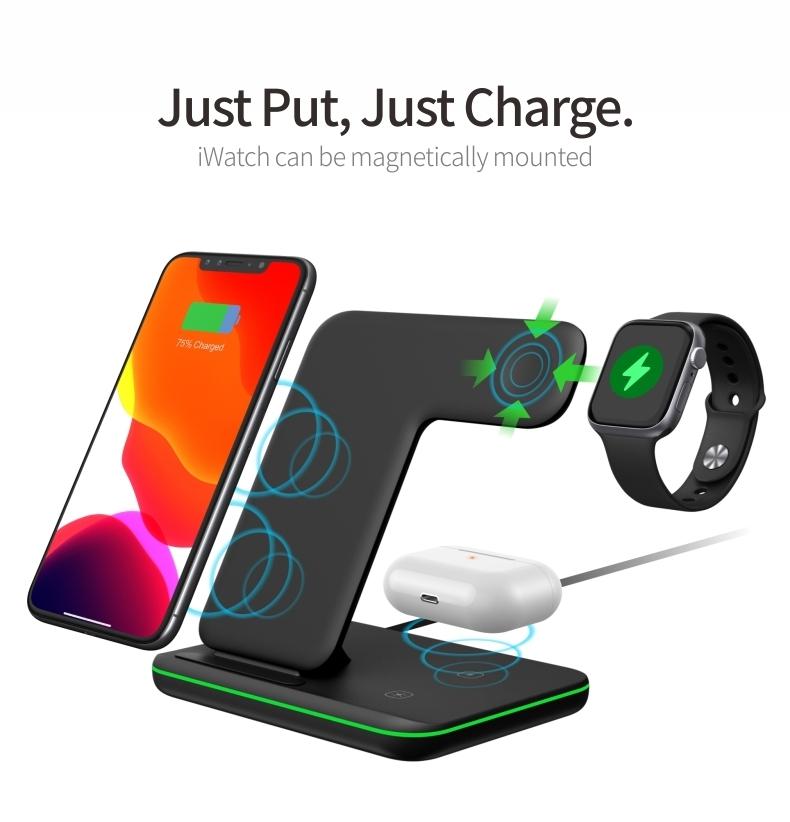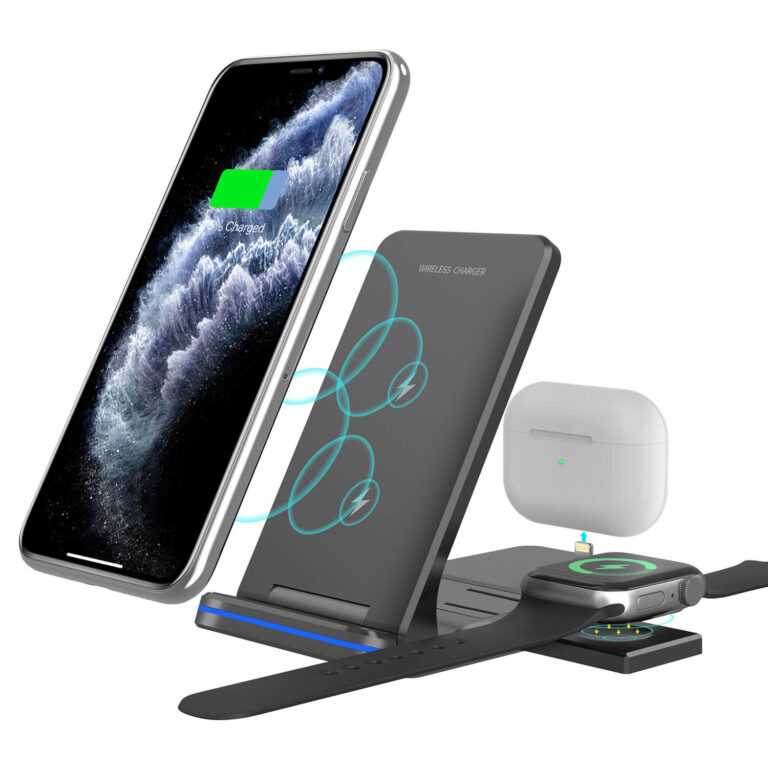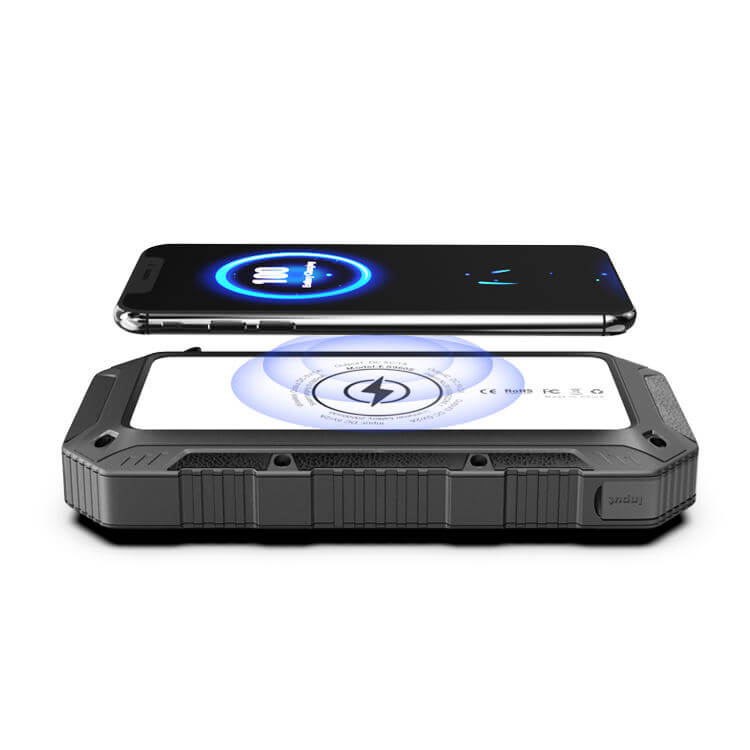What is Wireless Charging?
Wireless charging, also known as inductive charging and non-contact inductive charging, uses near-field induction, that is, inductive coupling, to transmit energy from a power supply device (charger) to a powered device, which uses the received energy to The battery is charged and used for its own operation at the same time. Basically, since the energy is transmitted between the charger and the powered device through inductive coupling, there is no need to use a wire to connect the two, so the charger and the powered device can have no exposed conductive contacts. That’s more convenient than wired charging.
History
Nikola Tesla believed that wireless power could be achieved with Tesla coils. But the experiment was unsuccessful.
In 1978, American inventor John George Bogle began experimenting with wireless charging of electric vehicles. [1]
In 1989, Japan Eight Electronics proposed the exact same circuit as WiTricity’s magnetic coupling resonance principle. [2]
In 1993, Daifuku Corporation of Japan realized the world’s first non-contact power supply and transmission system [3]. Its theoretical basis comes from the theory of John Boyce of the University of Auckland.
In 1994, the developers of Murata Manufacturing Company announced “Magnetically Coupled Resonance Technology”. [4][5]
In November 2006, Marin Soljacic [permanently dead link] of the Massachusetts Institute of Technology (MIT) succeeded in the 2-meter transmission experiment.
In January 2009, WiPower company developed the magnetic resonance standard “A4WP”, which supports power transmission up to 50W [6], the distance can be up to 5 cm [7], and the power transmission frequency is 6.78 MHz.
In July 2010, the Wireless Power Consortium (WPC) developed the magnetic induction standard “Qi”. A standard for mobile terminals of 5W or smaller has been developed.
In January 2012, IEEE released the PMA magnetic induction standard according to the IEEE Standards Association (IEEE-SA), and the industry formed the Power Affairs Alliance (PMA). Similar to Qi, this standard mainly establishes a set of safe, energy-saving inductive power standards, and implements intelligent power management.
In September 2015, A4WP and the PMA wireless charging organization merged into the AirFuel Alliance to promote a unified wireless charging standard.
In February 2019, WiTricity technology was integrated with Qualcomm Halo (Halo IPT from Auckland University) technology.
Two Standards
Since the merger of PMA and A4WP in 2015, there are currently two remaining standards for wireless charging.
The Qi standard of the Wireless Power Consortium (WPC), co-led by 24 board members.
The AirFuel Alliance (AFA)’s AirFuel Resonant (A4WP standard) and AirFuel Inductive (PMA standard), co-led by 15 board members.
WPC Council Members: AirCharge, ConvenientPower, Delphi Automotive, Fulton Innovation, Haier, HTC, Integrated Device Technology, Leggett & Platt, LG Electronics, MediaTek, Nokia Nokia), NXP, Panasonic (Panasonic), Philips (Philips), PowerbyProxi, Qualcomm (Qualcomm), Robert Bosch, Rohm, Samsung Electro-Mechanics (Samsung Electro-Mechanics), Sony (Sony), STMicroelectronics, Texas Instruments (Texas Instruments), Toshiba (Toshiba), Verizon Wireless.[8]
AFA Council Members: AT&T, Dell, Duracell, Energous, Flextronics, Gill Electronics, Integrated Device Technology Inc., MediaTek Incorporated, ON Semiconductor, Powermat, Qualcomm Technologies, Samsung Electronics, Samsung Electro-Mechanics, Starbucks, WiTricity Corp.[9 ]
Overview
Samsung Galaxy Note 10 series smartphones have ‘Wireless PowerShare’ feature
After the merger of A4WP and PMA to form the AirFuel Alliance, there are two different standards within it, and a dual-mode development solution is developed and a certification plan is proposed to try to make the two standards develop together in different application environments [10]. In the future, magnetic resonance will be integrated. With the magnetic induction technology, it promotes the unified standard of wireless charging [11].
AirFuel Resonant refers to the original A4WP standard, and AirFuel Inductive refers to the original PMA standard. The Qi standard of WPC is very similar to the standard of AirFuel Inductive, so it is not difficult for the charger or receiver to be compatible with both standards at the same time. But these two standards are completely different from AirFuel Resonant. WPC Qi and AirFuel Inductive are magnetic induction technology, and AirFuel Resonant is magnetic resonance technology. The principles of the two are completely different, so whether the charger or the receiver is compatible with these two technologies at the same time. very difficult.
At present, almost all smartphones with built-in wireless charging function on the market are compatible with both WPC Qi and AirFuel Inductive, such as Samsung’s Galaxy S6, S6 Edge, S7, S7 Edge, and most of the chargers support WPC Qi and AirFuel Inductive. AirFuel Resonant’s chargers and receivers are very rare, but AirFuel Resonant’s magnetic resonance technology has better charging efficiency and supports multi-device charging.
Development Trend
Originally, wireless charging was divided among three major groups. However, when A4WP and PMA merged into AirFuel, the entire competitive market layout will be completely changed. This tortoise and hare race will see its true chapter in the near future, especially in April 2015 in Japan. The Intel Technology Forum (Intel Developer Forum, also known as Intel Developer Forum) held a conference on wireless charging in the Asia-Pacific region, rewriting the historical positioning of wireless charging (because all computers are wireless and fully use A4WP), Taiwan’s media However, when Qi and AirFuel are still confused to mislead the public, it is indeed worthy of the public’s attention to this issue.
In the wireless charging group, when Intel (Intel) announced its participation in the Alliance for Wireless Power (A4WP), with Broadcom (Broadcom), Gill Industries, IDT, Qualcomm (Qualcomm), Samsung Electronics (Samsung Electronics) and Samsung Electro-Mechanics ( After companies such as Samsung Electro-Mechanics became one of the board members of A4WP; and according to reports from CNET and PCWorld, Intel has developed wireless technology that can make computers get rid of all power cords and adapter cables. The new technology is scheduled to be released in 2016. city. Intel also said at Computex on June 4, 2014 that devices equipped with “Skylake” chips will be able to charge wirelessly and transmit data wirelessly. This platform will use WiGig transmission technology, which can wirelessly connect desktop computers, monitors, mice, keyboards, etc., and no longer need wiring to connect various devices. The company also said the wireless module could be integrated into a computer as soon as 2015. However, in order to improve the wireless charging efficiency of mobile devices and allow devices other than small electronic products, such as notebook computers, tablet computers and other products, to enjoy the wireless charging function, A4WP has officially released a wireless charging standard with a power transmission power of up to 50 watts. , becoming the first standard in the three standard camps with a transmission power of more than 5 watts.
As for Duracell, which belongs to the PMA alliance, it plans to spend hundreds of millions of dollars to build wireless charging equipment for Madison Square Garden and Delta Air Lines lounges. Starbucks (Starbucks) and McDonald’s (McDonald’s) are also planning to install wireless charging pads in their stores to provide customers with the convenience of in-store charging, which will drive the rapid growth of the wireless charging market. When consumers buy products at this stage, they should start to worry about whether the products they choose will be eliminated in the future.
PMA and A4WP signed a preliminary agreement, and announced the merger news at CES 2015, and announced the completion of the merger in June of the same year, realizing the advantages of their respective standards and being compatible with each other’s standards. This means that the charging equipment of PMA and A4WP will be universal in the future, which is a good thing for both parties and even the entire wireless charging industry. After the alliance, PMA will gain the advantage of A4WP, which can wirelessly charge multiple devices at the same time under a single charger. Both parties manage and are compatible with charging points on the basis of PMA’s open API network, so A4WP, which is developing slowly in the commercial market, can obtain charging hotspots in places such as Starbucks and McDonald’s. Market popularization is a very beneficial cooperation.
There are at least four different wireless charging technologies on the market today in an attempt to power the billions of next-generation mobile devices in the market, and analysts expect winners in the technology to dominate the market by 2018 Wireless charging market for 100 million devices.
In May 2016, Intel announced its withdrawal from AirFuel, which shocked the entire market. It was originally thought that AirFuel would defeat the Qi standard set by the WPC Alliance. Unexpectedly, the situation changed overnight, and Qualcomm seemed to have quietly lowered its performance. Put in, so this standard war has fallen into a quagmire again.
The “Second Resonance” technology demonstrated at the Omron booth at Techno Frontier 2017 [12] maintained around 90% efficiency even when the coil axis was offset by 10 cm. The key is to build the resonant circuit only on the secondary side. If the configuration is on the primary side and the secondary side, the transmission distance becomes long, but if the axis of the coil is moved, the efficiency is extremely low.
Advantage
Safety: There is no energized contact design, which can avoid the danger of electric shock. On the implanted embedded medical device, the medical device implanted in the human body can be charged without damaging the body tissue without the need for wires to pass through the skin and other autologous tissues, avoiding the risk of infection.
Convenience: No need to connect with wires when charging, just put it near the charger. Technically, one charger can supply power to multiple electrical devices. In the case of multiple electrical devices, multiple chargers can be saved, multiple power sockets do not need to be occupied, and there is no trouble that multiple wires are entangled with each other. .
Shortcoming
Low charging efficiency: There is also a transformer in the general charger, but the transformer composed of the transmitting coil and the receiving coil for wireless charging has structural limitations, so the energy storage efficiency is theoretically slightly lower than that of the general charger. If the power supply is first connected to the wireless charger from the mains through the adapter (step-down, rectifier, voltage regulator), after multiple conversions, the efficiency will be lower.
Slow charging speed: Since most of the current receiving devices such as mobile phones limit the input power, the charging speed is slow.
High cost: The charger needs an electronic circuit to drive the coil, and the electrical equipment needs a power conversion electronic device, both of which also need a coil, and a high-frequency filter circuit is required to meet the FCC regulations, so the cost is lower than the direct cost. Contact is high.
Cannot be charged while moving: This problem only occurs on mobile devices. For example, an electric shaver cannot be removed from the charger while charging. If the battery in the electric shaver is completely exhausted, it cannot be used. The cord-connected charging is designed for continuous use.
Low compatibility: Different brands of wireless charging devices cannot be used interchangeably because there is no unified standard. However, in recent years, the industry organization WPC has begun to implement standardization, and it is expected that the standardization will be achieved. However, as the Qi standard was widely used in a variety of popular mobile phones at the end of 2012, it has not been able to be popularized and widely used. Although it is basically mentioned that “supporting wireless charging” means “supporting Qi wireless charging”, the future development is unknown.
Serious heat generation: Since the electronic equipment for power conversion will be lost during operation, and the electronic equipment is very close to the receiving equipment to be charged, the user will feel a high amount of heat during use. In fact, this is consistent with the heat generated by the adapter used in traditional line chargers. At present, the new products of Tesla Wireless Equipment Company solve this problem, so that the temperature during charging is basically the same as that of cable charging.
High battery life drain: When using normal wired charging, the device will let the charger supply power directly to the device and allow the battery in the device to rest. And when using wireless charging, the device doesn’t let the battery stop working. After the wireless charging fully charges the battery, the battery supplies power to the device. After consuming part of the power, the charger recharges the power into the battery. One to one, so that the battery is constantly being used, resulting in the loss of battery life.
Application
An electric vehicle EV1 is being charged using inductive charging
smart phone
Stylus
digital pen
Wearable Smart Products
floating horn
laptop
Desktop
electric razor
electric toothbrush
cell phone
Human heart embedded device
electric car
pure electric vehicle



